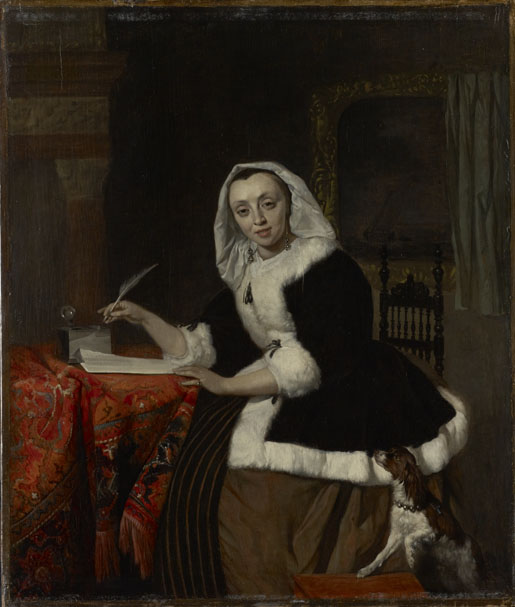A lady in a black fur-trimmed jacket and brownish skirt has paused from her letter to look at the viewer in a friendly fashion, with a slight smile crossing her face. Poised to resume writing as soon as the interruption has passed, she sits with her right hand holding her quill pen above an inkwell resting on the tapestry-covered table before her. Adding to the momentary character of the scene is the inquisitive small brown and white dog by the woman’s side, who peers toward the table while balancing expectantly on one paw. Although the content of the letter is unknown, it is undoubtedly amorous in nature, as is the case with virtually all Dutch seventeenth-century high-life genre scenes of letter writers. Images of ships at sea appear with some frequency in the background of such works, evoking the traditional notion that love is as changeable as the sea.1 A calm sea, as evident in this seascape, was considered a good omen for the relationship between two lovers.
Together with Metsu’s celebrated companion pieces Man Writing a Letter and Woman Reading a Letter in the National Gallery of Ireland, Dublin ((fig 1) and (fig 2)), Elegant Lady Writing at Her Desk from 1662–64 is one of the artist’s most mature depictions of elegant individuals engaged in amorous correspondence.2 Metsu was undoubtedly inspired to paint scenes of letter writers by Gerard ter Borch (1617–81), whose images of men and women writing, reading, receiving and sealing letters also prompted other artists, including Caspar Netscher (ca. 1639–84), Frans van Mieris (1635–81), and Johannes Vermeer (1632–75), to focus on this type of subject matter.3 The most influential of Ter Borch’s letter writing scenes was A Woman Writing a Letter of ca. 1655–56 (fig 3), although how the artist’s contemporaries would have known this painting is uncertain.4 Metsu certainly had seen it by 1657–59, when he painted A Woman Drawing (fig 4). In this work, he followed Ter Borch’s concept of a pensive female figure working at a table, but changed the subject to a drawing after a statue instead of a woman writing a letter.
In the present painting, Metsu presented the letter writer as a striking beauty smiling seductively at the spectator, a shift of focus that reflects the artist’s customary manner of adapting Ter Borch’s compositions in the 1660s. Metsu frequently appropriated Ter Borch’s subjects and figure groups, but loosened the social and emotional corset of that master’s elegant ladies and gentlemen. Metsu repeatedly depicted women interacting with and inviting the viewer to take part in courting rituals. Likewise, he generally placed his figures in more fancifully conceived, opulent interiors than did Ter Borch. Here, he placed the letter writer in front of a white and red marble mantelpiece comprising Corinthian columns and an elaborately carved frieze, which is based on a chimneypiece in the Burgomasters’ Council Chamber of the Amsterdam Town Hall.5 This building, designed by Jacob van Campen (1596–1657), was so splendid that the Dutch considered it to be the Eighth Wonder of the World.6 This visual reference to an architectural element in this grandiose building communicated to the viewer that the woman belonged to the highest echelons of Dutch society, an evocation of luxury that would have appealed strongly to Metsu’s wealthy Amsterdam clientele.
Many of Metsu’s genre scenes painted during the last few years of his life depict women whose facial features are based in various degrees on those of his wife, Isabella de Wolff. Elegant Lady Writing at Her Desk, however, is an exception. The woman’s pronounced eyelids and broad nose bridge are not those of the artist’s spouse. Her features are so distinctive that it is probable that the painting is a portrait of a woman posing as a letter writer; the ring on her finger may indicate that she is married. As such, the painting is similar to a portrait Metsu completed during the last year of his life that has a similar genre-like character: Portrait of Lucia Wijbrants(?), probably commissioned by the sitter’s husband, Jan Jacobsz Hinlopen.7
About two to four years after Metsu completed Elegant Lady Writing at Her Desk, Vermeer also painted an attractive letter-writing woman smiling subtly at the viewer (fig 5). Although the works differ in many respects, the paintings share the portrait-like character of the women, who differ from the other figure types in the rest of the artists’ oeuvres. It remains undetermined whether these similarities are the result of the two artists independently transforming Ter Borch’s image in the same way, or whether the Delft painter knew Metsu’s painting, which was probably part of a collection in Amsterdam.8
